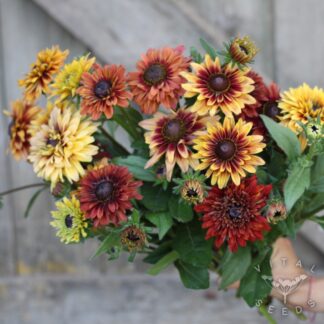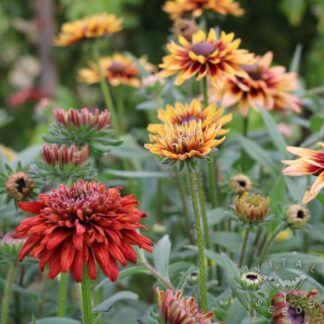Rudbeckia Seeds
How to grow Rudbeckia
How to grow Rudbeckia
Seed Sowing
Sow seeds indoors in February – April in pots or seed trays to be pricked out. Cover with a fine layer of vermiculite and keep at temperatures of around 20 degrees celsius. Germination takes around 10-15 days. Cold stratification may improve germination success, as does some warmth.
Transplanting
Transplant outside in May once danger of frost has passed, spacing plants 40cm apart. Rudbeckia can also be grown in containers.
Plant Care
Keep the area weed-free and watered during hot spells. You can mulch around the plants to keep in moisture and prevent weeds. Deadhead to prolong flowering. Stems may need support, especially in windy growing conditions.
Challenges
Rudbeckia are generally pest and disease-free but can be prone to powdery or downy mildew. Make sure to use the recommended spacing and not-overwater to keep the plants happy and less vulnerable to aphids.
Harvest
Pick the flowers often to encourage more flowers to form. Ideally harvest the flowers in the morning when temperatures are low and plant water content is high. Plants will arrange better if left to sit in water for a few hours after cutting. Rudbeckia have a very long vase life of up to two weeks.
To dry, cut stems and remove lower leaves and hang upside down in bunches in a cool, dark and well ventilated space.
Culinary Ideas
Rudbeckia are not edible.
Seed Saving
Harvest the individual flowers as they dry or whole plants once most of the flowers on the stem have dried.
Lay out on a sheet or use paper bags around each of the heads, hanging them upside down to dry further. You will be looking for a crisp, brittle cone. Once dried they can be threshed to release the seeds or use your thumb to scrape the seeds free. Winnow to remove any further chaff and clean the seeds.
Store in a cool dark place.
Showing all 2 results
-


Rudbeckia – Sahara (Organic) ***NEW FOR 2026***
£2.50 Add to basketRudbeckia – Sahara (Organic) ***NEW FOR 2026***
Stunning variety of Black Eyed Susan that produces single or double flowers with soft brown centres in glorious shades of caramel, copper and pink. The soft mix of colours of the blooms make this a great choice for the cutting garden. They pair beautifully with late summer blooms like amaranth and sunflowers. For maximum vase life pick when the buds are just about to open.
(Approximate seed count – 250) £2.50
£2.50 -


Rudbeckia – Hirta (Organic)
£2.50 Add to basketRudbeckia – Hirta (Organic)
A wonderful variety producing an abundance of yellow, crimson and mixed blooms over a long period. We love this rudbeckia for its bold flowers. They are a real eye catcher and keep giving over a long season. As a cut flower best picked when the buds are just about to open.
(Approximate seed count – 500)£2.50
Showing all 2 results




